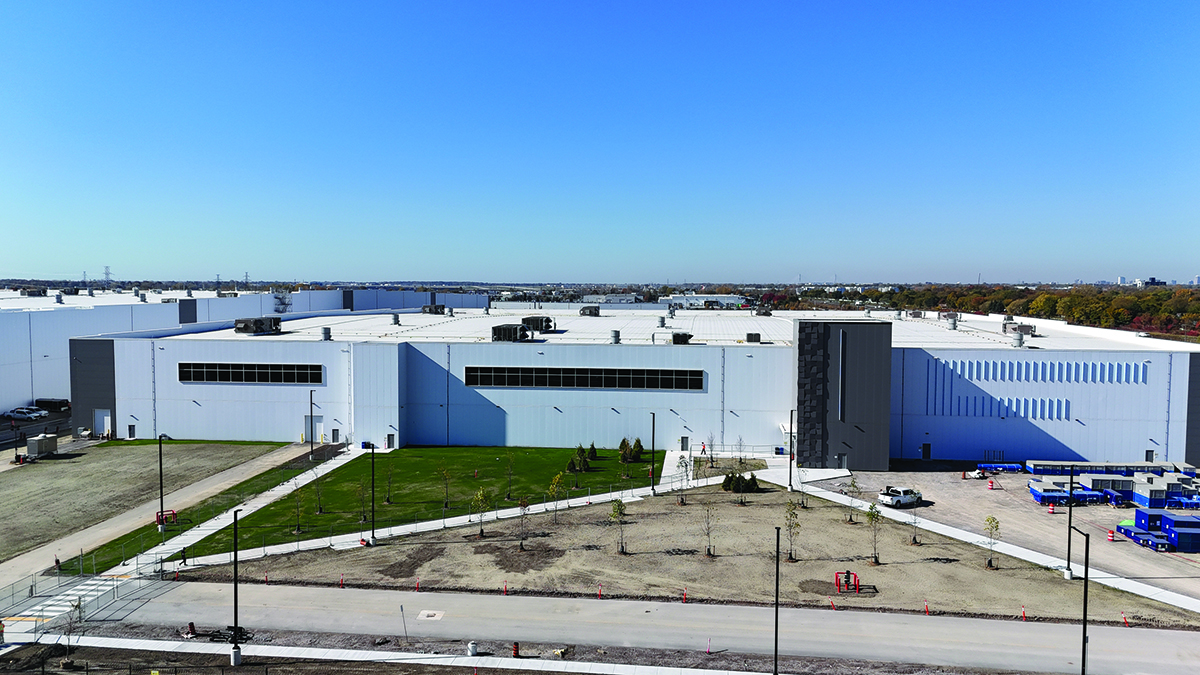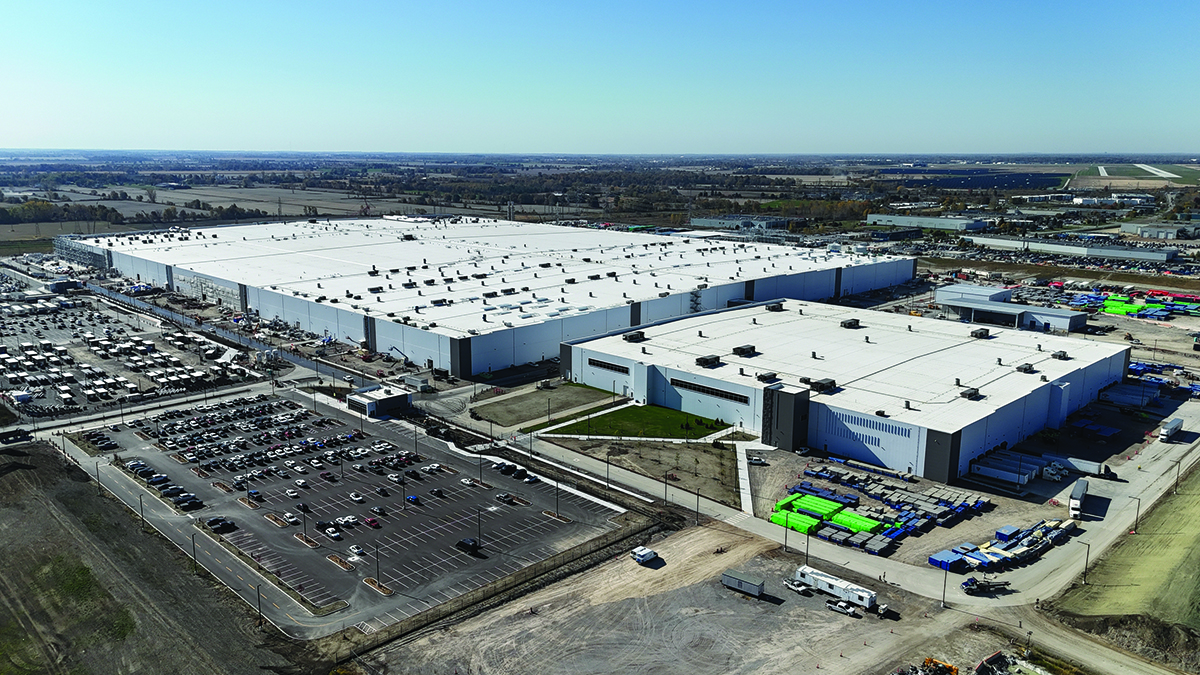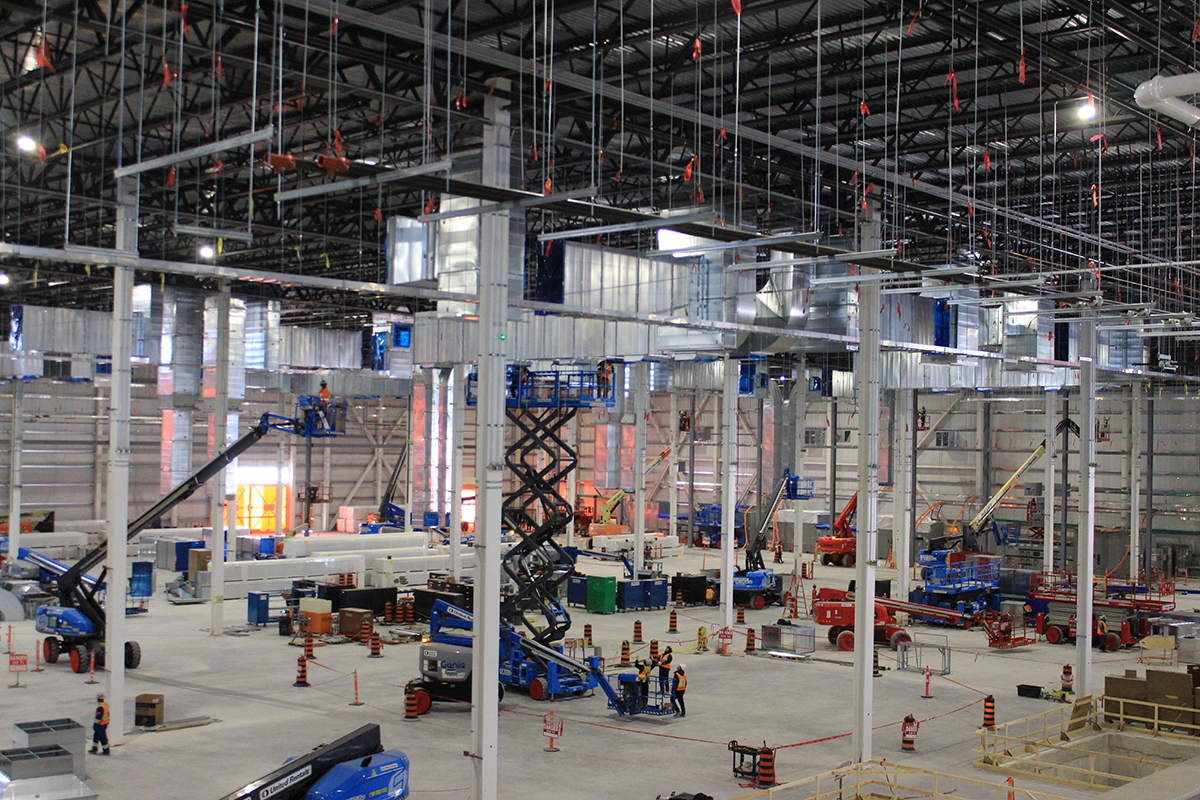INDUSTRIAL: Leading the Charge
Toronto Sheet Metal Contractors Association member Black & McDonald installed HVAC systems and duct for Ontario’s first electric vehicle battery plant. The work required extensive communication with numerous trades.
 While the electric vehicle revolution may not be on the rapid timetable the industry originally predicted, SMACNA members are constructing the infrastructure EVs will need.
While the electric vehicle revolution may not be on the rapid timetable the industry originally predicted, SMACNA members are constructing the infrastructure EVs will need.
This includes installing HVAC systems in the factories where the batteries powering the electric vehicles of today and tomorrow are built.
In 2022, Toronto-based industrial, commercial and institutional construction contractor Black & McDonald was awarded a CA$550 million ($397 million USD) contract to install the HVAC, piping, plumbing and mechanical wiring for the main cell building of a 4.5 million-square-foot EV battery complex in Windsor, Ontario. Located across the river from Detroit, Windsor is the heart of the Canadian automotive industry. Numerous auto parts suppliers, as well as manufacturing plants for Ford Motor Co. and Stellantis N.V. are located in the city. Black & McDonald, one of Canada’s largest contractors, is a CA$2.7 billion ($1.9 billion USD) company with 6,800-plus employees, more than 40 offices and projects across North America.
The new plant, officially known as NextStar Energy, is a CA$6 billion joint venture between Stellantis and LG Energy Solution. When fully in operation, the plant will have the ability to produce enough batteries to power 450,000 electric vehicles per year. It’s scheduled to be completed in late 2025.

Black & McDonald Project Manager Stephen Payton is overseeing the HVAC work on the battery plant project. The job required him and several other key employees to relocate from the Toronto area to Windsor, about four hours away, for several months. He said it was his first time on a job of this size.
The cell building uses 254,000 linear feet of duct, made from about 5 million pounds of metal. Duct sizes ranged from 26 to 16 gauge. It was mostly galvanized, Payton says. The company also installed stainless steel breaching and “a good amount” of fabric duct —about 50,000 linear feet, ranging from 8 to 64 inches in diameter.
 Black & McDonald fabricated some metal ductwork at its main 20,000-square-foot sheet metal shop in Toronto. Payton estimated that at the peak, about 30 Black & McDonald employees were working on ductwork for the EV battery plant. The company also used a smaller sheet metal shop in Windsor to make some components and subcontracted with another Toronto fabricator for a large portion of the materials.
Black & McDonald fabricated some metal ductwork at its main 20,000-square-foot sheet metal shop in Toronto. Payton estimated that at the peak, about 30 Black & McDonald employees were working on ductwork for the EV battery plant. The company also used a smaller sheet metal shop in Windsor to make some components and subcontracted with another Toronto fabricator for a large portion of the materials.
“Block ends, Ductmate frames, spiral — there’s a bunch of different items that we did there,” Payton says, adding “most of our fabrication was done between a third-party company that we contracted with in Toronto and our main shop in Scarborough (Ontario).”
He estimates that about 60 workers fabricated duct for the project. Installation was fully handled by Black & McDonald workers — about 325 of them, Payton says. In early 2023, work on the plant was briefly halted over a funding dispute regarding tax incentives between Stellantis, LG and the Canadian and Ontario governments. An agreement was reached and work resumed by summer. Work on the cell building was unaffected.
The project has been an “interesting” adventure, according to Payton. “If a job goes too smoothly and never has a single hiccup, something’s wrong,” he says. “There’s no such thing as ‘perfect construction’ in my mind. This job has definitely had its fair share of hurdles.”
Among the biggest hurdles, Payton says, was getting used to interacting with trades workers from across the country. Workers from provinces such as Saskatchewan, Alberta or British Columbia may have a different way of approaching tasks.
“All these people have their way of doing things,” he says. “When you try and standardize a process, a lot of very prideful workers want to do it their way. They have a hard time taking direction. We tried to create a standardized process so that way everything was done the same way.” And that led to some long meetings: 10-hour days with nine hours spent in meetings was a common occurrence. “That left very little room to actually get work done,” he says.
As of mid-May, Black & McDonald’s work is approaching its end. “We still have, construction-wise, about a month and a half to two months worth of work left,” Payton says. “Just buttoning everything up, deficiencies, finishing some change orders, installations, things of that nature.”
Payton says he learned a lot working on the NextStar EV battery plant project that will help him with future projects, whether in automotive or other industries. “A lot of the things learned on jobs like these are transferable to almost any project,” he says. “Whether it’s for design of HVAC, design of piping systems, electrical, stacking work, managing labor and power or quality control documentation. There’s so many facets to it that it’s almost like it writes its own book on how to run future projects.”
Published: August 28, 2025
IN THIS ISSUE
A SMART Partnership
SMACNA's President reflects on his long history of collaboration with SMART General President Michael Coleman.
AI in Construction: Navigating Opportunities and Risks for SMACNA Contractors
These next few years will be important for the construction industry, as artificial intelligence transforms key elements of how contractors operate.
ARCHITECTURAL: Crafting a Custom Vision in Steel
Thompson Solutions Group brought Plan Architecture’s wood-look steel façade to life at Little Priest Tribal College, combining precision, speed and SMACNA-backed expertise.
Artificial Intelligence: An Introduction
Since late 2022, when ChatGPT was introduced, we’ve been hearing more and more about AI, usually with more hype than explanation.
HVAC: Welded With Precision, Driven by Purpose
MechOne builds more than ductwork as it shapes the future of Colorado’s HVAC industry.
INDUSTRIAL: Leading the Charge
Toronto Sheet Metal Contractors Association member Black & McDonald installed HVAC systems and duct for Ontario’s first electric vehicle battery plant. The work required extensive communication with numerous trades.
Making AI Work: Tips & Tricks for Contractors
We are in the midst of another technology revolution, one as important as the internet or mobile phones, with artificial intelligence (AI) tools becoming increasingly accessible and practical for contractors of all sizes.
Progress, Partnerships and Possibility
SMACNA's CEO examines some of the association's work in critical subject matter areas.
RESIDENTIAL: How Zipf-Air Boosted Profits by Going Residential
By flipping his business model and focusing on customer service, high-end brands and Indoor Air Quality, John Zipf turned a commercial-heavy HVAC company into a thriving residential operation.
Trump Backs Biden-Era EO Mandating PLAs for Large Federal Construction Projects
In a surprising continuation of his predecessor’s labor policy, President Donald Trump’s administration announced on June 12, 2025
Welcome New SMACNA Members
What’s in H.R. 1, The New Tax Bill, and What It Means for SMACNA Contractors
Workforce Evolution Trends: What Construction Leaders Should Know
The dynamics of the construction labor workforce are shifting, fueled by a growing labor shortage, evolving employee expectations and a sizable portion of the workforce nearing retirement.


